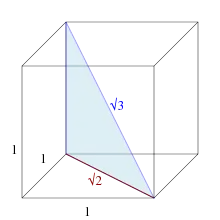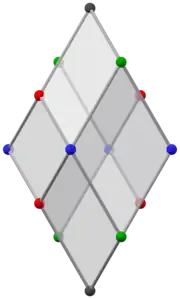 The height of an equilateral triangle with sides of length 2 equals the square root of 3. | |
| Representations | |
|---|---|
| Decimal | 1.7320508075688772935... |
| Continued fraction | |
The square root of 3 is the positive real number that, when multiplied by itself, gives the number 3. It is denoted mathematically as or . It is more precisely called the principal square root of 3 to distinguish it from the negative number with the same property. The square root of 3 is an irrational number. It is also known as Theodorus' constant, after Theodorus of Cyrene, who proved its irrationality.
As of December 2013, its numerical value in decimal notation had been computed to at least ten billion digits.[1] Its decimal expansion, written here to 65 decimal places, is given by OEIS: A002194:
- 1.732050807568877293527446341505872366942805253810380628055806
The fraction (1.732142857...) can be used as a good approximation. Despite having a denominator of only 56, it differs from the correct value by less than (approximately , with a relative error of ). The rounded value of 1.732 is correct to within 0.01% of the actual value.
The fraction (1.73205080756...) is accurate to .
Archimedes reported a range for its value: .[2]
The lower limit is an accurate approximation for to (six decimal places, relative error ) and the upper limit to (four decimal places, relative error ).
Expressions
It can be expressed as the continued fraction [1; 1, 2, 1, 2, 1, 2, 1, …] (sequence A040001 in the OEIS).
So it is true to say:
then when :
It can also be expressed by generalized continued fractions such as
which is [1; 1, 2, 1, 2, 1, 2, 1, …] evaluated at every second term.
Geometry and trigonometry



The square root of 3 can be found as the leg length of an equilateral triangle that encompasses a circle with a diameter of 1.
If an equilateral triangle with sides of length 1 is cut into two equal halves, by bisecting an internal angle across to make a right angle with one side, the right angle triangle's hypotenuse is length one, and the sides are of length and . From this, , , and .
The square root of 3 also appears in algebraic expressions for various other trigonometric constants, including[3] the sines of 3°, 12°, 15°, 21°, 24°, 33°, 39°, 48°, 51°, 57°, 66°, 69°, 75°, 78°, 84°, and 87°.
It is the distance between parallel sides of a regular hexagon with sides of length 1.
It is the length of the space diagonal of a unit cube.
The vesica piscis has a major axis to minor axis ratio equal to . This can be shown by constructing two equilateral triangles within it.
Other uses and occurrence
Power engineering
In power engineering, the voltage between two phases in a three-phase system equals times the line to neutral voltage. This is because any two phases are 120° apart, and two points on a circle 120 degrees apart are separated by times the radius (see geometry examples above).
Special functions
It is known that most roots of the nth derivatives of (where n < 18 and is the Bessel function of the first kind of order ) are transcendental. The only exceptions are the numbers , which are the algebraic roots of both and . [4]
See also
Other references
References
- ↑ Komsta, Łukasz (December 2013). "Computations | Łukasz Komsta". komsta.net. WordPress. Retrieved September 24, 2016.
- ↑ Knorr, Wilbur R. (June 1976). "Archimedes and the measurement of the circle: a new interpretation". Archive for History of Exact Sciences. 15 (2): 115–140. doi:10.1007/bf00348496. JSTOR 41133444. MR 0497462. S2CID 120954547. Retrieved November 15, 2022 – via SpringerLink.
- ↑ Wiseman, Julian D. A. (June 2008). "Sin and Cos in Surds". JDAWiseman.com. Retrieved November 15, 2022.
- ↑ Lorch, Lee; Muldoon, Martin E. (1995). "Transcendentality of zeros of higher dereivatives of functions involving Bessel functions". International Journal of Mathematics and Mathematical Sciences. 18 (3): 551–560. doi:10.1155/S0161171295000706.
- ↑ S., D.; Jones, M. F. (1968). "22900D approximations to the square roots of the primes less than 100". Mathematics of Computation. 22 (101): 234–235. doi:10.2307/2004806. JSTOR 2004806.
- ↑ Uhler, H. S. (1951). "Approximations exceeding 1300 decimals for , , and distribution of digits in them". Proc. Natl. Acad. Sci. U.S.A. 37 (7): 443–447. doi:10.1073/pnas.37.7.443. PMC 1063398. PMID 16578382.
- ↑ Wells, D. (1997). The Penguin Dictionary of Curious and Interesting Numbers (Revised ed.). London: Penguin Group. p. 23.
- Podestá, Ricardo A. (2020). "A geometric proof that sqrt 3, sqrt 5, and sqrt 7 are irrational". arXiv:2003.06627 [math.GM].


